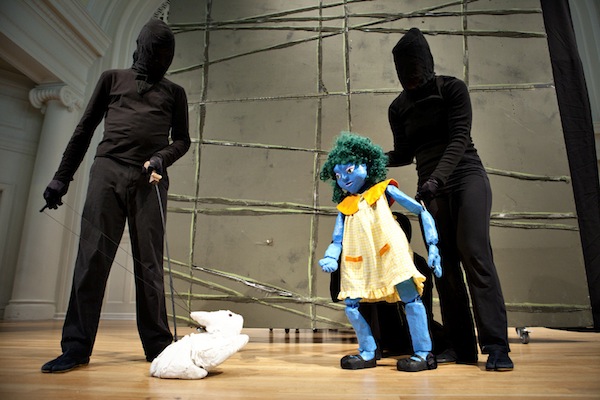
Puppetry, performance and imagination at the Detroit Institute of Arts
This past Sunday, I had the pleasure of taking in a performance of Blair Thomas & Company’s “A Kite’s Tale,” at the Detroit Institute of Arts (a Knight Arts grantee). It was a puppet show unlike any I had ever seen, involving a live performance by pianist Kathryn Goodson of Modest Mussorgsky’s “Pictures at an Exhibition,” and featured an engrossing combination of puppetry, costumes and theater. The performance was without dialogue, though the audience was given a brief and lively primer on the storyline at the start. The story itself was intensely surreal and imaginative, involving two “tricksters,” a dancing rabbit and a little girl with a bad temper and a red kite.
Following in the tradition of Japanese bunraku theater, some of the puppets were life-sized, and others required several puppeteers to control. There was also a costume element to the show, including an enraged version of the story’s main character, a little girl who would lose control of her temper and transform from a three-foot tall puppet into a towering version of herself played by a costumed performer. The first time the transformation occurred, and the giant version of the little girl stepped suddenly onstage, the audience audibly gasped, and I saw many of the younger kids in the audience clinging tightly to their mothers. It was an electric moment, and just one of many throughout the show. The handcrafted and hand-painted puppets and dynamic performances transformed the event beyond the traditional concept of puppet show, and into an in-motion work of highly-refined folk art.
I had the pleasure of catching up with Blair Thomas to ask him a few questions about the performance. The result of our conversation is below:
Jeremy Schmall: Was there anything in particular that inspired “A Kite’s Tale?” Did the story emerge over time and through a process, or was it the sort of thing that sprung out fully formed? Blair Thomas: The story emerged over time as I worked on this show starting in 2005. I listened to the music repeatedly and just imagined characters from the sound of movements. It was clear there was some giant character, I imagined some mercurial trickster characters that would create some mischief, and I imagined a young child skipping through the woods — I was convinced there was some Sloth character too, but he never emerged.
JS: What kind of time investment goes into a production like this, in terms of creating the story, doing the choreography and constructing the puppets? BT: It takes months to make the puppets — and the ones we are using now have been built a couple of times to get it right. Then rehearsal is a long process — I start with an imagined scenario of action that quickly is forced into revision as we stage moments to the music. But the music dictates the narrative — I knew that at one point there would be a chase scene and another there would be a fight, another a moment of contemplative introspection, etc. For example, the movement where the little girl first becomes angry and turns into a giant was first a scene where the giant was playing with a butterfly but in the end crushes it. Then it was a stand off scene between the tricksters and the giant.
JS: Does your company fabricate all the costumes and puppets yourselves? What is that process like? BT: A group of designers built the puppets. There were mold makers, someone else who figured out the mechanisms of their operations, a couple of different people designed and built the costumes, I painted most of them. This process has been ongoing with this show.
JS: How did you originally get involved with doing puppet theater? BT: As a boy I lived in a small town without a movie theater or much else, and I got the idea of a puppet show. Without having seen one and with some store bought marionettes, I started making shows for birthday parties and church events.
JS: I really enjoyed the use of different kinds of puppets throughout the performance, especially the bunraku puppets, which I had never seen before. What is your history with bunraku? BT: Over the past years I have worked with different versions of the bunraku doll— I’ve done several human-size types. I like the direct response the puppeteer can give them.
JS: I loved the dramatic moment when the giant version of the little girl steps on stage for the first time, which sent shockwaves through the audience. Were you worried at all about scaring some of the kids in that moment? BT: No not worried— surprise will often scare young kids — but surprise in the theater is one of its greatest assets. There are many kinds of surprise; this is an obvious one, but dynamic.
JS: I noticed a lot of literary influence in your works, including Federico Garcia Lorca and an adaptation of Moby Dick. Do you consider yours to be literary-focused company, or is literature just one of the many influences on your work? BT: I approached Mussorgsky’s score in the same way I have written word texts. A writer/composer can put a structural integrity into their writing that in itself is a form of storytelling. As a puppeteer, I am interested in the works that aren’t created for the stage because the puppet theater operates with a unique theatrical language itself, and the original source material is just one component of the performance. So I do take inspiration off of pre-existing works — I am interested in participating in the dialogue of tradition with our culture at large.
Detroit Institute of Arts, 5200 Woodward Ave., Detroit; 313-833-7900, dia.org
Recent Content
-
Artsarticle ·
-
Artsarticle ·
-
Artsarticle ·


